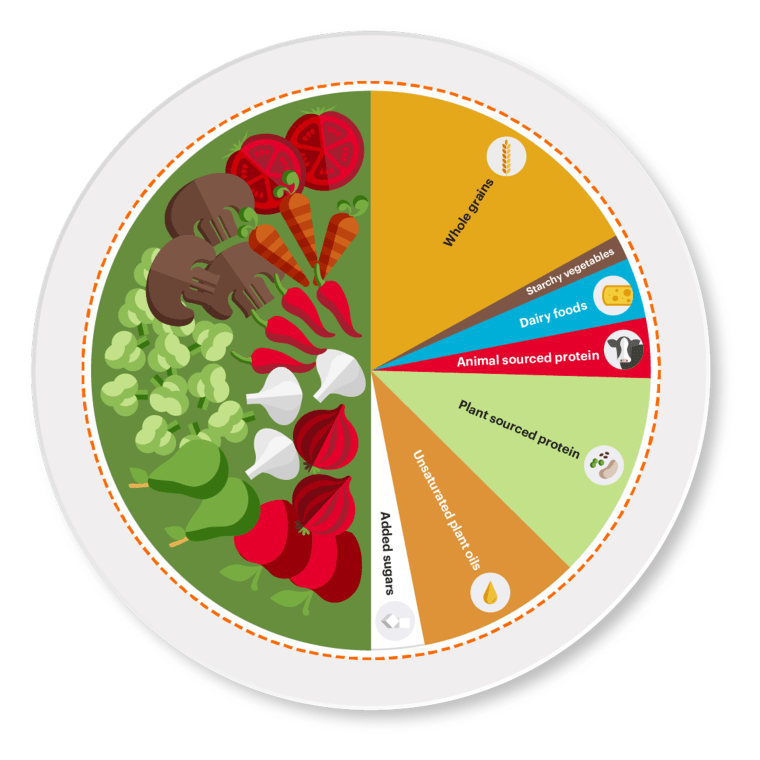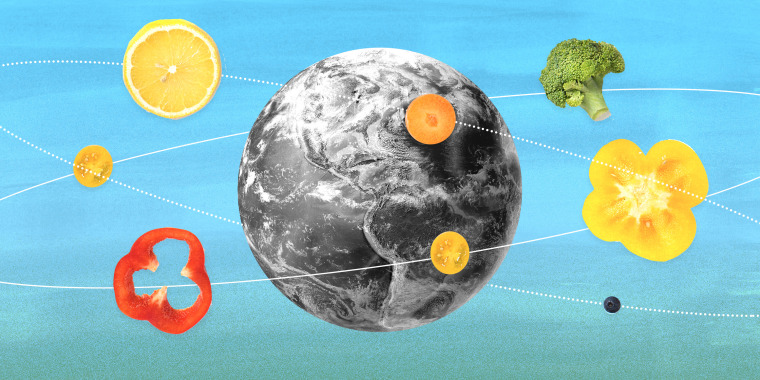What if one of the best ways to feel healthy and confident in our bodies is to shift eating habits in a way that betters the world around us?
In 2019, a global group of experts formed the EAT-Lancet Commission and released the planetary health diet as a science-based, accessible solution to the growing population in a struggling environment. For three years, an international team of 37 scientists studied and researched practices around the world and developed a well-rounded approach to eating and producing food for people and the planet.
What is the planetary health diet?
The planetary diet is a flexible, plant-based diet developed by scientists who examined the best possible way of shifting eating habits to better individual human wellness and environmental health.
Registered dietitian and author Frances Largeman-Roth said the planetary health diet is easily represented by a plate that is half covered by fruits and vegetables, and half covered with a combination of whole grains, plant protein, a small amount of animal protein (and as little beef possible), plant oils, dairy foods and a small amount of added sugars.
The diet favors unsaturated fats and limits refined grains, highly processed foods and added sugars.
What are the basics to know when following the planetary health diet?

"Like a vegetarian or vegan diet, the planetary health diet is largely based on eating plant foods, including fruits, vegetables, whole grains and plant proteins. It’s not restrictive and includes a wide variety of foods," Largeman-Roth told TODAY.
According to Fabrice DeClerck, one of the leading scientists who worked on the report, the diet suggests eating 0 to 120 grams of beef per week, which is just over 1/4 pound (.26 if you're looking at the labels at the market). For those who are or want to be vegan or vegetarian, that works well as long as they find other sources of protein and vitamin B12.
Anyone who wants to continue eating meat, that's fine. The adjustment will just be enjoying it as a treat once a week and, ideally, looking to source meat from people who raise the cattle with environmentally friendly or regenerative practices.
What does a daily meal plan look like?

"The recommendations were published using daily values. I’d recommend that your readers not sweat the daily values so much, but ask how they can eat within the ranges provided on a weekly basis," DeClerck told TODAY. "Look for a balance of meals with no meat, or a combination of meals like stir frys with smaller portions of meat, and save that burger or roast (if you want it) for every other week, or a special monthly meal."
Largeman-Roth provided one example of a day on the diet:
- Breakfast: Whole-grain cereal, fresh fruit, chia seeds or nuts and a dollop of plain yogurt.
- Lunch: Large salad with leafy greens, tomatoes, olives, chickpeas, 2 ounces of fish and a sprinkle of feta.
- Dinner: Cauliflower tacos.
- Snacks: Fresh fruit, whole grains, nuts, etc.
Because the diet is not very restrictive with lots of options, there are many meal plan possibilities. Some of DeClerk's personal favorites are a quinoa burger his wife makes, Mexican food (think burritos: light on the carnitas, heavy on the fresh veggies and guac) and paella.
What does the research say about the planetary health diet?
EAT's global analysis showed how many parts of the world over-consume unhealthy foods like beef, other meats and sugar; while people in other parts of the world would benefit from eating more meat to help address anemia or other types of nutrient deficiencies.
Universally, DeClerck and his team saw an "underconsumption of protective foods," like whole grains, fruits, nuts, seeds and vegetables.
"From the stats point of view, if we were able to provide the planetary health diet to everyone everywhere we would be able to avert 11 million deaths per year, and produce enough food for 10 billion people within environmental limits," the science director told TODAY.
According to Largeman-Roth, The National Academy of Sciences predicts that food production will have to double to keep up with the population.
"Growing plants uses fewer natural resources ... and produces less CO2 emissions than growing animals, which means that a focus on plants can help us navigate a growing population and changes to our climate," she told TODAY.
One of the most difficult aspects of the planetary health diet is finding ways to get it to underserved communities, countries and food deserts. While some non-profits, farmers and restauranteurs work to get fresh, healthy foods on the tables of urban communities who have little access to these types of food, DeClerck said we have a lot to do to make this type of diet doable for everyone.
"We need much more effort in ensuring that a diversity of fresh foods are more available and affordable to all — and we need to nudge food companies and food services to increase rather dramatically healthy and tasty options of processed and packaged foods," he told TODAY.
What are the health benefits?
Like the Mediterranean diet and many popular plant-based diets, Largeman-Roth said the planetary diet can help lower the risk of heart disease, Type 2 diabetes, metabolic disease and certain types of cancer. It automatically provides more fiber and phytonutrients (plant nutrients), magnesium, potassium, iron and folate. It can also help to reduce inflammation and oxidative stress that can promote cell damage (which accelerates aging and can lead to chronic diseases) and may promote a sharper mind with fewer memory problems over time.
"Many of us in high-income countries simply are eating too much, 3,500 calories per day compared to the 2,000 to 2,500 recommended," DeClerck told TODAY. "That’s not good for us, and it means that in an increasingly resource limited world, we are wasting land, air and water that is in short supply."
What are the environmental benefits?
"It's about putting less carbon in the atmosphere, and leaving more land available to nature to do what nature does best: regulate climate, produce clean water and produce a huge diversity of goods and benefits," DeClerck told TODAY.
The research team defines a healthy environment as one with stable climates, good water quality, land for biodiversity and water in the rivers. At the current rates of over-consumption and production of meats, we will be unable to continue feeding the growing population, which the report foresees increasing by 2 billion in just 30 years.
"Some foods, meats in particular, require more land, energy and often water to produce. When meat is over-consumed, as it often is in developed countries, our take, or portion of land, and water used for food increases at the expense of other critical planetary boundaries," DeClerck told TODAY. "There is good evidence now that if we fail to transition to healthy diets, that we are also likely to fail in stabilizing climate, or achieving the goals set by the Paris Climate Agreement."
Related:


